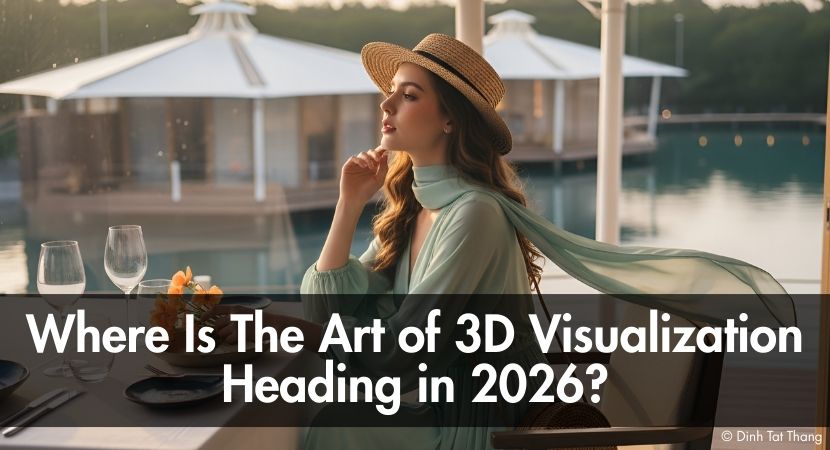
The year 2026 is coming and the 3D visualization industry is seeing a wave of uncertainty as a result. An ever-evolving network of artificial intelligence technologies that can generate, refine, and even reimagine our ideas is now standing in front of what was previously a craft of patience, accuracy, and storytelling. Join us as we uncover, through the words of the community itself, how our art may transform in the years ahead!
The discussion of AI and 3D visualization in 2022 was abstract, an interesting possibility, which became a reality by 2025. A new creative culture was subtly shaped as AI upscalers, texture generators, denoisers, and image-to-render tools were included into routine operations. However, the fear of what would happen to the artist increased along with the speed of innovation.
It is up for question whether or not this new culture is genuinely innovative, and it frequently leads to a wide range of discussions and debates on many platforms. Through four recent VWArtclub polls and dozens of comments, the community spoke honestly. Its voice paints a clear enough picture, not of fear, but of transformation.
The Pulse of the Industry – Insights from VWArtclub Polls
It's important to keep in mind that statistics in 3D visualization are always accompanied by feelings before delving into numbers and charts. An artist's journey, whether it be one of curiosity, anxiety, enthusiasm, or resistance, is reflected in each vote. These four VWArtclub polls allow us to track not only trends but also the human pulse that characterizes our industry's current status.
Poll 1: Where Is the Art of 3D Visualization Heading?
In the VWArtclub Group, we recently got two projects that were made purely from basic 2D AutoCAD files using a complete AI methodology; not even a clay base model or 3D modeling software or render engine was used.
I was surprised to see how cohesive the architecture looked from several angles. I gave it my approval for publication, assuming it only had some AI upscaling for improvement. I later got in touch with the artist directly after reading remarks casting doubt on the legitimacy of the procedure. All the photos were entirely AI-created, he said.
This moment perfectly symbolizes where we stand today. A point where even professionals have to stop and wonder: Is it real? Is it 3D? Is it AI? Or is it something entirely new, a blend of all three?
The findings, which came from 216 votes, show that the field is already in a new era. According to more than half of the participants, artificial intelligence complements human craftsmanship rather than replacing it in the existing partial AI workflow. Another 35% predict a Hybrid Era, meaning that artists of the future will need to be proficient in both AI and 3D.

| Poll Question | Where is the art of 3D visualization heading? |
|---|---|
| Full AI Workflow – 3D software will soon be obsolete. | 6% |
| Partial AI Workflow – AI will assist but not replace traditional tools. | 56% |
| Traditional 3D Forever – 3D modeling and rendering will always remain essential. | 3% |
| Hybrid Era – The future belongs to those who master both AI and 3D. | 35% |
| Too Early to Tell – Let’s wait and see how things evolve. | 0% |
A remarkable range of emotions was depicted in the discussion that ensued after this survey. Some members expressed awe at AI's rapid progress. Others expressed worry that the industry loses its sense of authorship or purpose.
As I personally noted in the discussion, we are already living in a Partial AI Workflow era. Artists who wish to survive must learn to adapt, mastering both, the old and the new. But I also acknowledged that the future likely points toward Full AI Workflow, where automation handles the heavy lifting, and creativity focuses on meaning and storytelling.
Simon Oudiette, from HOROMA STUDIO, captured the tension precisely: "It's funny that AI, in less than three years, has eaten big chunks of a workflow that's more than three decades old. The hybrid approach will remain the most interesting, until AI becomes as directable as traditional methods."
Meanwhile, Ciro Sannino, from REALISTIC INTERIORS, added a grounded perspective: "Hybrid doesn't mean safe. Many traditional 3D jobs will vanish, especially in big firms that no longer need as many visualizers. The demand will shrink, even if high-end artists remain essential."
Not all comments carried concern, though. Kris Lee Taylor reminded everyone that technology never truly erases tradition: “Even in 2026, there will still be people sketching with pen and paper, and clients appreciating that human touch. Tools evolve, but creativity survives.”
The overall sentiment? Realism and artistry are not at war; they're learning to coexist. AI is not stealing the brush as it's simply offering a new one. The question is not whether we'll adapt, but how gracefully we'll do it.
Poll 2: Do ArchViz Quality Standards Still Matter in the Age of AI?
Given that AI Upscalers, refining tools, and generative post-production are now commonplace in practically every artist's workflow, it is only reasonable to wonder if the ArchViz quality standards are being subtly reinterpreted or if they still make sense.
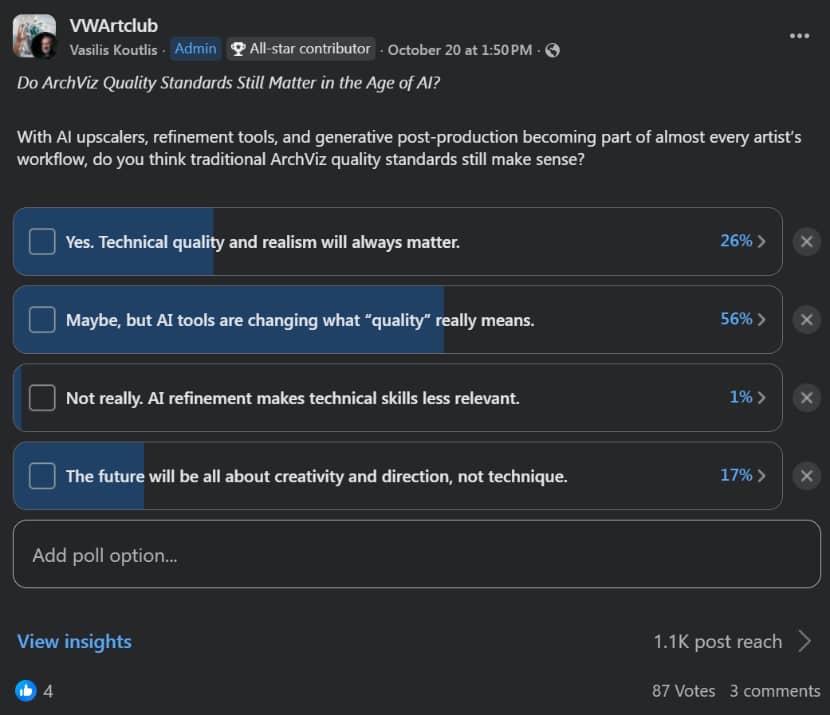
| Poll Question | Do ArchViz quality standards still matter in the age of AI? |
|---|---|
| Yes. Technical quality and realism will always matter. | 26 % |
| Maybe, but AI tools are changing what “quality” really means. | 56 % |
| Not really. AI refinement makes technical skills less relevant. | 1 % |
| The future will be all about creativity and direction, not technique. | 17 % |
Out of 87 votes, more than half agreed that AI is reshaping the very idea of quality. Realism, once the ultimate benchmark of visualization mastery, is no longer the only measure of excellence. Today, a render's impact is often judged by its emotion, its message, or its story rather than by the precision of its reflections or even the accuracy of its geometry.
Marino Bañón summarized this transition beautifully: "We've moved from judging quality by how real it looks to judging it by how much it conveys. True excellence now lies in emotion, atmosphere, and storytelling; that's where real 'quality' lives today."
Felix Koo brought in a pragmatic reminder: "It doesn't matter what we artists think, it's what clients find value in." His comment points to a growing truth in our industry: perception of quality has shifted from the creator's vision to the client's expectation. In a world where AI can produce almost instant perfection, emotional resonance and client satisfaction often outweigh technical precision.
The overall takeaway from this short discussion is that AI hasn't completely destroyed quality but it has already transformed it. Perfect lighting and flawless textures are no longer rare; anyone can achieve them. What remains rare and valuable is the intent behind an image.
As one member commented privately, "AI gave us unlimited polish, but only humans can give meaning." This shift doesn’t lower standards; it raises the bar for emotional intelligence and storytelling within ArchViz. Technical excellence will always matter, but its purpose has probably evolved from proving skill to expressing vision.
Poll 3: What's Holding the ArchViz Industry Back?
Over the past few years, the ArchViz field has evolved faster than ever, but at the same time, many professionals feel that something has stalled. Innovation is happening everywhere, AI rendering, faster CPUs, GPUs, and better tools, yet progress somehow feels flat.
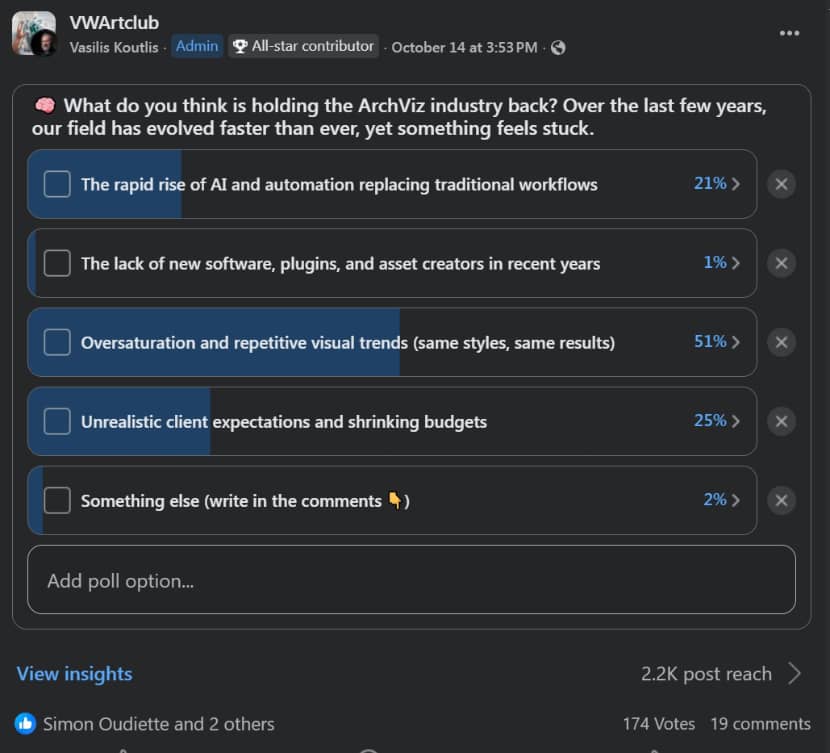
| Poll Question | What do you think is holding the ArchViz industry back? |
|---|---|
| The rapid rise of AI and automation replacing traditional workflows | 21 % |
| The lack of new software, plugins, and asset creators in recent years | 1 % |
| Oversaturation and repetitive visual trends (same styles, same results) | 51 % |
| Unrealistic client expectations and shrinking budgets | 25 % |
| Something else (write in the comments) | 2 % |
With 174 total votes, more than half of the participants identified oversaturation and repetitive visual trends as the biggest obstacle. Even with significant technological progress, the creative output frequently seems to be caught in a rut, with social media being dominated by the same color schemes, lighting configurations, and camera angles.
As Simon Oudiette put it, "AI isn't the problem. ArchViz was already boring way before it appeared." His point resonated strongly within the thread, as others agreed that the industry's creative plateau may come less from technology itself and more from the culture surrounding it. "It's a bit of a chicken-and-egg situation," Simon continued, "whether it's the studios, the clients, or social media expectations, something keeps recycling the same visual language."
Hrvoje Čop added another sharp observation: "The fact that 'good enough' imagery has been democratized to a point where it costs a few cents and takes a few minutes has changed the game completely." His argument underlined the hard truth that high-quality visuals are no longer rare, and therefore, no longer valued the same way. Most clients today simply want 'good enough', not 'extraordinary' and that has reshaped both artistic ambition and financial sustainability.
Several members, including Bichoy Fathi, voiced frustration that major software developers have failed to keep up. "3ds Max, C4D, and Blender are ignoring the AI wave", he wrote. "There's no real innovation, same old workflows, while clients now think AI can replace artists and make it easy. But it's not that simple."
At the same time, Davide Buonocore touched on a deeper issue called perception. "Many clients still treat visualization as a purely technical service rather than a strategic communication tool. Until that changes, it's hard to expect any real qualitative leap."
And for Thanish Afridhi, the structural imbalance within the industry is equally limiting: "Architecture firms that provide 3D services as a side task are afraid to explore new horizons. Freelancers face impossible deadlines and small budgets. Only dedicated ArchViz studios really push the craft forward and there are too few of them."
The comments reveal a collective awareness that the problem isn't only technological but also cultural, economic, and systemic. AI and automation were mentioned as concerns, but more as symptoms than causes.
As Ali Gym pointed out, "ArchViz may have reached its peak in quality, with or without AI. It's inflation all over again: money, speed, and efficiency have taken control."
In short, what holds the industry back is not a lack of tools, but a lack of differentiation. Everyone can now produce clean, photoreal images. What's missing is the why behind them, the narrative and the emotional fingerprint.
The poll's conclusion couldn't be clearer: the next leap in ArchViz will not come from software updates or AI breakthroughs, but from creative reinvention. Until artists, studios, and clients demand individuality over repetition, the field will remain predictable.
Poll 4: Inflation and the Creative Struggle
Although the majority of the previous VWArtclub conversations were on changes in technology, this survey revealed a whole new type of strain that impacts livelihoods as well as workflows.
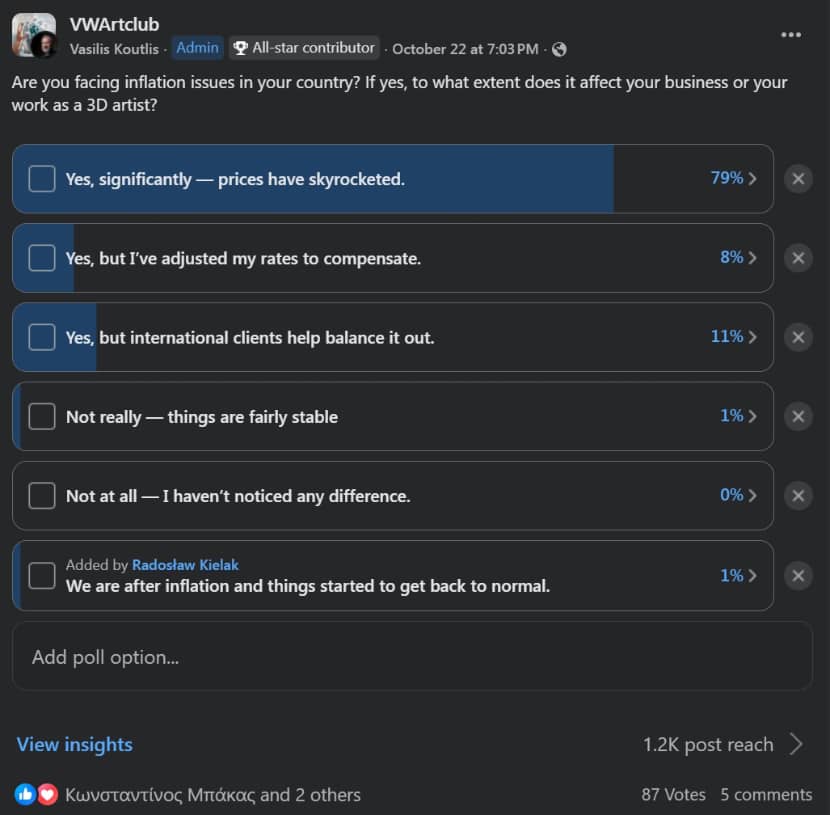
The numbers speak for themselves. Nearly eight out of ten artists confirmed that inflation has significantly affected their work, with rising prices and stagnant client budgets creating one of the toughest economic periods in recent memory.
As Ciro Sannino pointed out, the issue extends far beyond regional borders: "How is it possible that hyperinflation is happening all around the world at the same time? Something in the system broke… possibly voluntarily." This global simultaneity suggests a structural imbalance rather than isolated crises.
In my own reply, I noted that this situation feels like a double-edged sword: "You either raise your prices and risk losing loyal clients, or you keep your rates steady and see your profits erode. Both paths come with risks. The challenge is finding a sustainable balance between value, stability, and growth."
Miguel Casso, commenting from Peru, added a unique perspective: "There's no inflation issue here, but in 3D work, the overuse of AI is already having similar effects. Many agencies are cutting costs by replacing artists with AI workflows. Some results are good, some are terrible, but it's not the brands asking for it, it’s the agencies themselves." His point connects two worlds, economic and technological, showing how both inflation and automation compress the perceived value of creative work.
In Greece, Konstantinos Bakas described a similar reality: "Prices for literally everything have gone up. Chaos, Autodesk, Adobe, they've all raised their prices, but client budgets haven't followed. Competing globally makes it even tougher when artists from countries with lower costs undercut the market. Having international clients helps, but inflation is still very present." His reflection captures a key pain point for small and mid-sized studios: globalized competition in an unbalanced economy.
The comments reveal a shared fatigue, less about lost opportunities and more about the psychological weight of uncertainty. When energy bills, software subscriptions, and taxes all rise faster than project budgets, creativity inevitably takes a back seat to survival.
In that sense, this poll reminds us that technological revolutions mean little if the economic foundation collapses beneath them. The 3D industry may be innovating faster than ever, but artists are still human, bound by real-world costs that AI cannot optimize.
If there's any silver lining, it lies in the resilience of the community. Despite financial strain, most participants continue adapting by raising rates carefully, diversifying clients, and finding balance through international work.
Acceleration and Denial – The Fastest Shift in Creative History
According to the maker of the YouTube video "Architectural Visualization Is Dying - These AI Tools Prove It," new AI renderers that can respect geometry, materials, and lighting logic will replace most visualization teams by 2026.
He points to platforms like Vizoid and Render AI, which can produce photorealistic effects using just simple 3D imports, and predicts an exponential curve of improvement; flat during 2024, steep in 2025, and unstoppable afterward.
Yet what resonated most with the community wasn't the fear, but the tone of inevitability. As one VWArtclub member noted, "We've heard this before, from photography to Photoshop to Unreal. The jobs didn't vanish; they changed shape."
Denial is the true threat, not AI. Acting as though nothing has changed in the landscape merely slows down adaptation. "You don't have to enjoy it, but you have to adapt," the video ends. Our polls reflect the same sentiment: artists recognize that evolution doesn't require permission, but they still don't want to lose their craft.
Adapting to a Hybrid Future
"Is AI Replacing 3D Artists & VFX?" is the second featured video. "What You Need to Know" takes a more collected, philosophical stance when discussing the matter. Its message is unambiguous: according to the World Economic Forum, 86% of creative professions worldwide will change, yet change does not equate to destruction.
A warning about emotional paralysis is given by the narrator. He exhorts producers to concentrate on what they can control rather than worrying about obsolescence:
- The software they master, naming Blender and Unreal Engine as ecosystems "too big to fail".
- The network they build, because exposure often outweighs talent.
- The range of skills they weave together, forming a "creative web" that keeps them agile.
The video ends on a poetic note: we used to build sandcastles knowing they’d wash away, but we built them anyway because creation itself was joy.
The comment area of VWArtclub resonated with that reflection. Many people concurred that the future of 3D art depended more on why we create it than on what we produce. "AI is not a threat, it's a gift," one participant commented, "if it lets us rediscover the pleasure of producing, not simply the pressure of delivering."
What the Community Really Thinks.
From the dozens of thoughtful comments under these polls, several themes keep reappearing.
Some members see AI as the "next render engine", a natural extension of technological history. They highlight how AI tools can already handle repetitive tasks with clean geometry, enhanced textures, and generated concepts while freeing artists to focus on atmosphere and emotion.
Others remain cautious. They worry that the industry might become flooded with quick, soulless visuals, erasing the depth and intent behind good composition. As one artist warned, "If everyone can make a 'beautiful' image in seconds, the definition of beautiful will have to change."
This is seen by a smaller but fervent group as a creative renaissance. For the first time in decades, they contend, imagination is no longer constrained by technical limitations. Some even welcome AI as a new collaborator, a colleague who challenges them to refine their artistic judgment and is unpredictable.
Regardless of one's position, curiosity is what ties them all together. Although they are aware that the landscape is changing, everyone is experimenting, trying, and adjusting because they are hesitant to let go of their artistic DNA.
2026 and Beyond – The Rise of the Hybrid Creator
So, where is the art of 3D visualization really heading? I would say that the answer isn't binary but hybrid.
By 2026, 3D artists will no longer be defined by the software they use, but by the clarity of their vision. AI tools will become part of the background. Creativity will probably move upstream, into curation, direction, and storytelling.
Studios that survive will be those that evolve their pipelines without losing their artistic identity. Those who resist entirely may preserve tradition, but risk irrelevance. Those who surrender entirely to automation may produce faster, but not necessarily better.
The sweet spot, as the VWArtclub community repeatedly suggests, lies somewhere in between: "Use AI to build faster, but still feel slower."
That human slowness, for example, the decision to move a chair two centimeters because it feels right, is an essence that no algorithm can replicate. It's not nostalgia but craftsmanship and what we use to say: "The eye of the artist".
Conclusion – Art Has Never Been About Tools
If there's one message that emerges from the voices, polls, and reflections gathered from our community, it's this: "Art was never about the tools". I still remember this repetitive answer in the common question: "V-Ray or Corona?"
From pencil to pixels, from renders to reality, artists have always found ways to make technology serve emotion. I think that AI doesn't end that story but it is trying to write the next chapter.
In 2026, the best visualization won't be the most realistic or the most detailed but the one that still makes viewers feel something and as long as we remember that, the art of 3D visualization will never die. It will just keep changing shape, much like the light that defines it.
Thank you for reading! I hope this article offered some food for thought about where our art is heading. Whether we agree or disagree on the path forward, one thing unites us all: our shared love for 3D art and our wish to see it thrive.
Kind regards & Keep rendering! 🧡
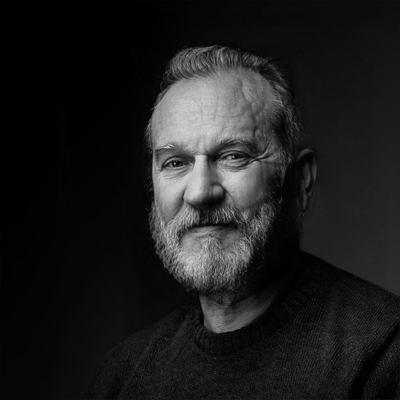
About the author
Vasilis Koutlis, the founder of VWArtclub, was born in Athens in 1979. After studying furniture design and decoration, he started dedicating himself to 3D art in 2002. In 2012, the idea of VWArtclub was born: an active 3D community that has grown over the last 12 years into one of the largest online 3D communities worldwide, with over 160 thousand members. He acquired partners worldwide, and various collaborators trusted him with their ideas as he rewarded them with his consistent state-of-the-art services. Not a moment goes by without him thinking of a beautiful image; thus, he is never concerned with time but only with the design's quality.

